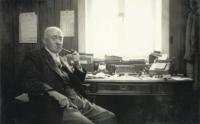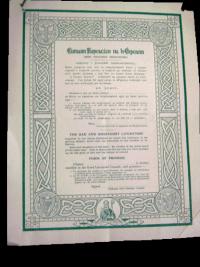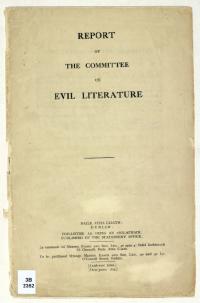A shot across the bows of journalism in the Irish Free State
Published in 20th-century / Contemporary History, Features, Issue 5 (Sept/Oct 2012), Volume 20
Editor D.C. Boyd—his crime was to publish what he termed the ‘clean medical facts’ of the Breen case.
On 29 October 1929 the Catholic national newspaper, The Standard, proudly proclaimed that the first prosecution under the Censorship of Publications Act 1929 had been successful. The case had been brought against the editor of the Waterford Standard, D.C. Boyd. Boyd was an outsider in Waterford society—a northern Protestant—with a history of investigating corruption and wrongdoing amongst the political and wealthier classes of Waterford. The pages of the Waterford Standard indicate that Boyd was a man with a passion for social justice and a strong belief in the mission of journalism to explore and expose without fear or favour, themes that would emerge during his trial.
Euphemisms
The reporting of sexual crime in the Free State press, where it appeared at all, generally resorted to euphemisms like ‘a grave offence’ rather than the exact nature of the crime and with few other details to illustrate or contextualise events for the reader. In the reporting of the case of local theatre-owner L. Breen, whom, it was alleged, had had unlawful carnal knowledge of a thirteen-year-old girl in his employ, Boyd’s inclusion of the ‘clean medical facts’ left the reader with no room for doubt about the exact nature and brutality of the alleged offence. Whatever Boyd’s motivation for including the medical evidence, it provided a powerful and shocking backdrop to the allegation that Breen was alleged to have utilised his social standing and economic power to intimidate the girl’s mother and to have shown disdain for her daughter’s distress and her family’s desire to seek justice.It was the ‘medical’ elements of his reporting that were deemed to have put Boyd in contravention of the new censorship legislation. Boyd rigorously defended his decision to report the case in the way he did on public interest grounds, claiming that sexual assault cases ‘often did not get publicity and it was publicity that perpetrators of these sorts of offences feared most’. Boyd also asserted that:
‘In cases of this particular kind very often attempts were made to suppress their publication . . . I often lose money by my policy of publicity, but I hold I have a duty to society and that it is in the interest of the public that newspapers should be free and independent.’
Boyd’s reference to ‘losing money’ was borne out by the remarks of the bishop of Waterfordremarks of the bishop of Waterford.
Lack of debate on the impact of the act
Boyd consistently argued that those who held prominent and powerful positions in society should be fully exposed to the public eye when they behaved badly. Indeed, Boyd was asked under cross-examination at his trial by the prosecuting barrister, a Mr Ryan, ‘If the defendant had been a clergyman of some religious denomination, would you consider it in the interest of the public to publish them?’ Boyd replied in unequivocal terms. ‘Yes, if he were a clergyman he should get full publicity for an offence of this nature.’In addition to his journalistic zeal and moral indignation, it may be the case that Boyd’s own lack of understanding regarding the content and contemporary status of the Censorship of Publications Act 1929 may have led him to go further than was legally safe. Under questioning at his trial, Boyd informed the court that he had not read the act fully prior to the publication of the Breen trial report.The fact that Boyd, a keen observer of state actions who had robustly defended press freedom in the courts at an earlier date, had not fully understood the scope of the act is in itself a testament to the lack of debate nationally on the detail and impact of the act as it passed through the Dáil. Whether Boyd was as ignorant of the legislation as he indicated in his evidence is a moot point, but it does seem that he was wrong-footed regarding the enforcement of the act prior to the establishment of the Censorship Board, which was to police the provisions of the act.The judge ruled that Boyd was guilty as charged and fined him £25. In his summation, the judge said that he felt that this case was just the sort of thing that the act had been introduced to curb, and made the point that he had the power under the act to impose a fine of up to £500, an amount equivalent to c. €20,000 at today’s values, enough to have bankrupted a small local newspaper in 1929. The judge also pointed out that he had the power to imprison Boyd for six months. In his summation the judge confidently concluded that, following the judgement, similar offences would not be repeated by the press. Whilst the judge’s confidence in the deterrent nature of the outcome must be viewed as entirely speculative, the one thing that cannot be doubted is that the potential financial and personal implications for any Irish editor transgressing the new law were spelt out very clearly in this case.

The enrolment form of the Irish Vigilance Association’s ‘Good Literature Crusade’ against ‘the bad and unsavoury literature imported to our shores’ and the Report of the Committee on Evil Literature (1926)—both expressions of the concern of Catholic commentators about the corrosive effects of the foreign (i.e. British) press in Ireland. (National Library of Ireland)
Harsher penalties in relation to reports of court proceedings
The nature of the potential fine and prison sentence against Boyd highlights a feature of the Censorship of Publications Act 1929 that has largely been overlooked by commentators. Much of the scholarly focus on the act has been on its impact on literature and Ireland’s artistic community, yet under its terms a maximum fine of £50 could be imposed for the publishing of a banned book, whilst under the section ‘Offences in Relation to the Publication of Reports of Judicial Proceedings’ the more severe penalties cited by the trial judge (£500 and six months’ imprisonment) could be imposed. This weighting against the reporting of the more graphic aspects of courtroom proceedings was born directly out of the concerns expressed by Catholic commentators and the Report of the Committee on Evil Literature (1926) in relation to the ‘polluting’ of the masses by the foreign (British) press and the corrosive effect that this could have on the native psyche and Ireland’s international standing.The case against the Waterford Standard under the Censorship of Publications Act 1929 offers us a glimpse of how the interplay between politics, social class and church authority in Free State Waterford affected Irish journalism in the period when the fledgling state was seeking to define itself and its place in the world—and, indeed, what it was to be Irish.

the Report of the Committee on Evil Literature (1926)
The success of the action against Boyd cannot have failed to send a clear signal to editors at regional and national level regarding the parameters within which they were expected to operate. Editors already keen to disassociate themselves from the ‘anti-Catholic’, ‘anti-Irish’ label attached to the few who had raised concerns during the passage of the act were highly unlikely to want to repeat Boyd’s actions, or even, it appears, to discuss his conviction and its wider implications. Indeed, the contemporary reporting of the case against Boyd and its consequences is notable only by its absence, outside of the triumphal coverage in The Standard. It is certainly the case that the coverage of crime, in particular sexual crime, was to remain largely off limits to Irish journalists during the 1930s and ’40s and beyond. As Kieran Woodman has noted, the culture of censorship that the act facilitated engendered a high degree of risk avoidance through self-censorship by editors in relation to wider social and criminal matters for decades to come. HI
Anthony Keating is a senior lecturer in social work and social care at Edge Hill University, England.
Further reading
J. Horgan, B. O’Conner & H. Sheehan (eds), Mapping Irish media (Dublin, 2007).K. Woodman, Media control in Ireland, 1923–1983 (Carbondale, 1985).
















